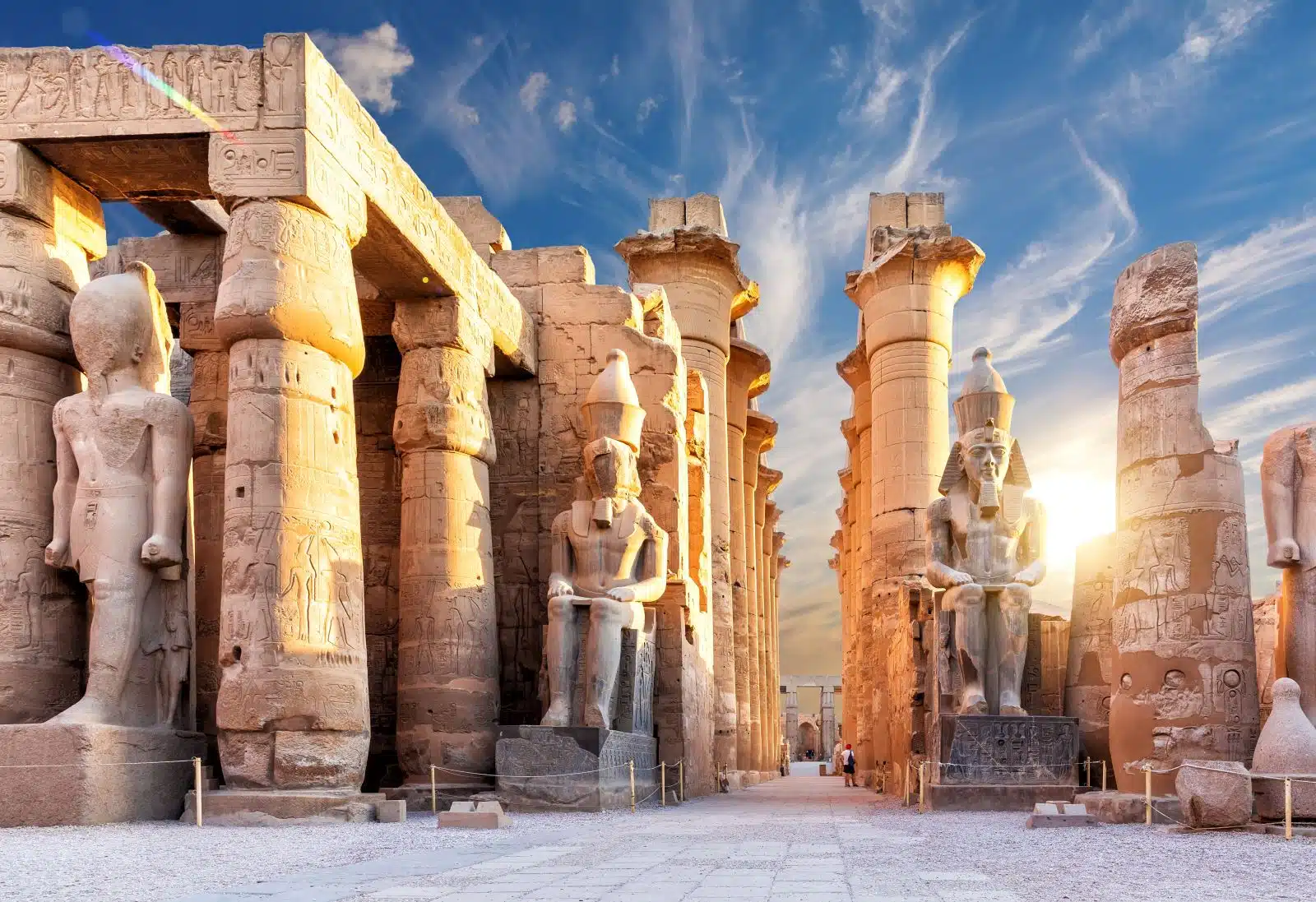A journey through Egypt takes you through ancient history, natural wonders, and cultural richness. This land, cradled by the Nile River and framed by deserts and seas, has captivated travelers, scholars, and dreamers for millennia. Egypt offers diverse discoveries, from the legacy of its pharaohs and the timeless flow of the Nile to the vibrant life of its modern cities and the serene beauty of its deserts. This guide aims to unveil the charm of Egypt, guiding you through its most iconic destinations and hidden gems. Whether you’re drawn to the magic of Alexandria’s Mediterranean coast, the White Desert’s surreal landscapes, or its ancient cities’ historic grandeur, Egypt promises an adventure that intertwines the past with the present, inviting you to explore its mysteries and celebrate its living culture. As we journey through these destinations, we’ll provide insights into their historical significance, natural beauty, and cultural vibrancy, offering tips to enrich your experience in this land where civilization dawned.
1. The Pyramids of Giza
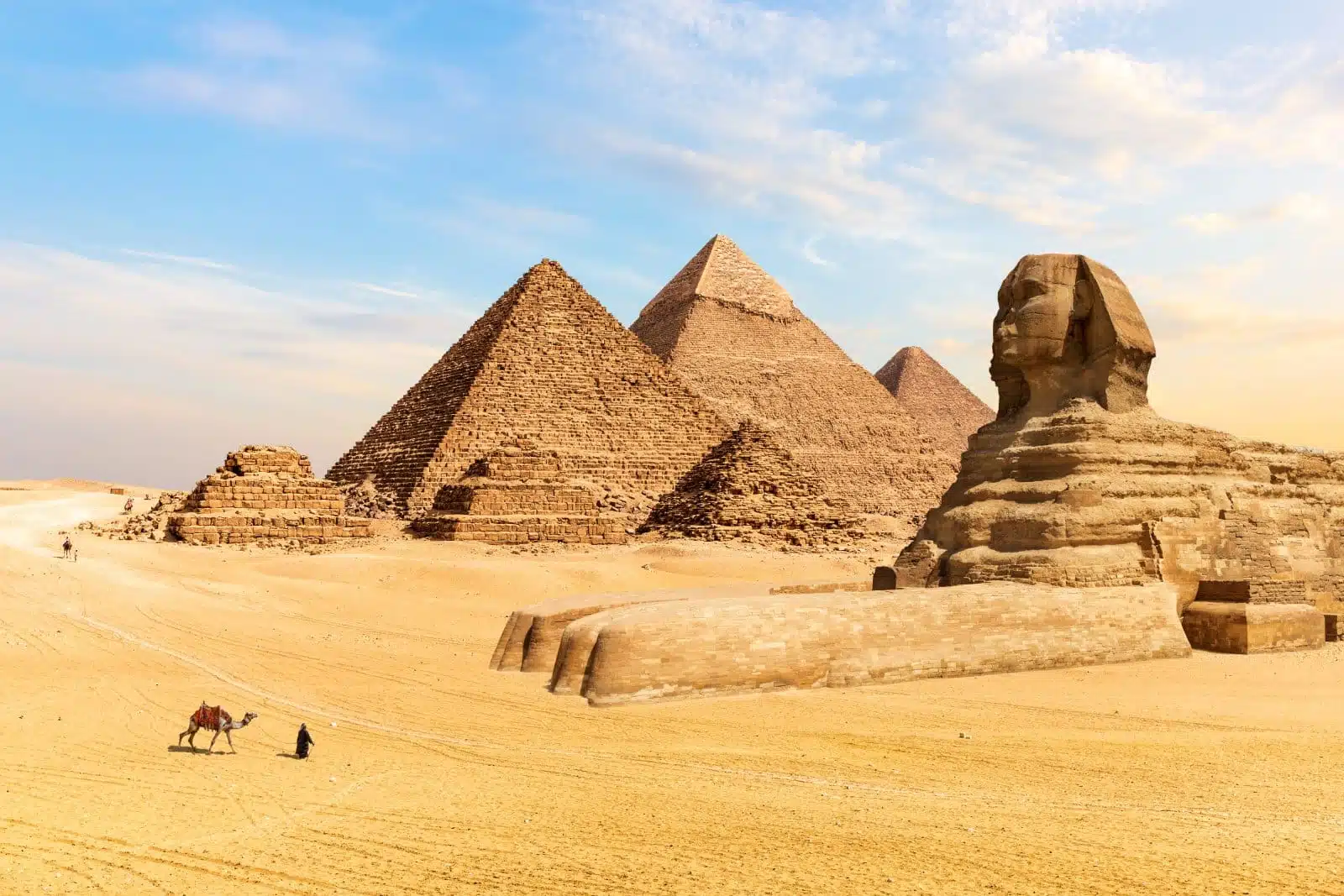
Image Credit: Shutterstock / AlexAnton
The Pyramids of Giza, an emblem of Egypt’s ancient grandeur, stand majestically on the outskirts of Cairo, against the vast Sahara Desert. This architectural trio and the Sphinx have captivated travelers, historians, and archaeologists for centuries. The Great Pyramid, one of the most impressive architectural feats of the ancient world, was the tallest man-made structure for over 3,800 years. A visit to this complex offers a chance to marvel at the sheer scale of these monuments and provides insight into the sophisticated civilization that constructed them around 4,500 years ago. The Great Pyramid’s interior passages, the plateau’s panoramic views, and the Sphinx’s gaze form an unforgettable experience that bridges the past and present. The site’s significance as a burial ground for pharaohs, its alignment with celestial phenomena, and the intricate artistry in the construction techniques underscore the advanced knowledge and cultural depth of ancient Egyptian society.
Insider’s Tip: Visit the pyramids early in the morning to avoid the crowds and the heat. Consider booking a private tour for a more in-depth exploration of the site.
When to Travel: The best time to visit is from October to April, when the weather is cooler.
How to Get There: The Giza pyramid complex is located just outside Cairo and is easily accessible by taxi or tour bus from the city center.
2. Luxor’s Karnak Temple and the Valley of the Kings
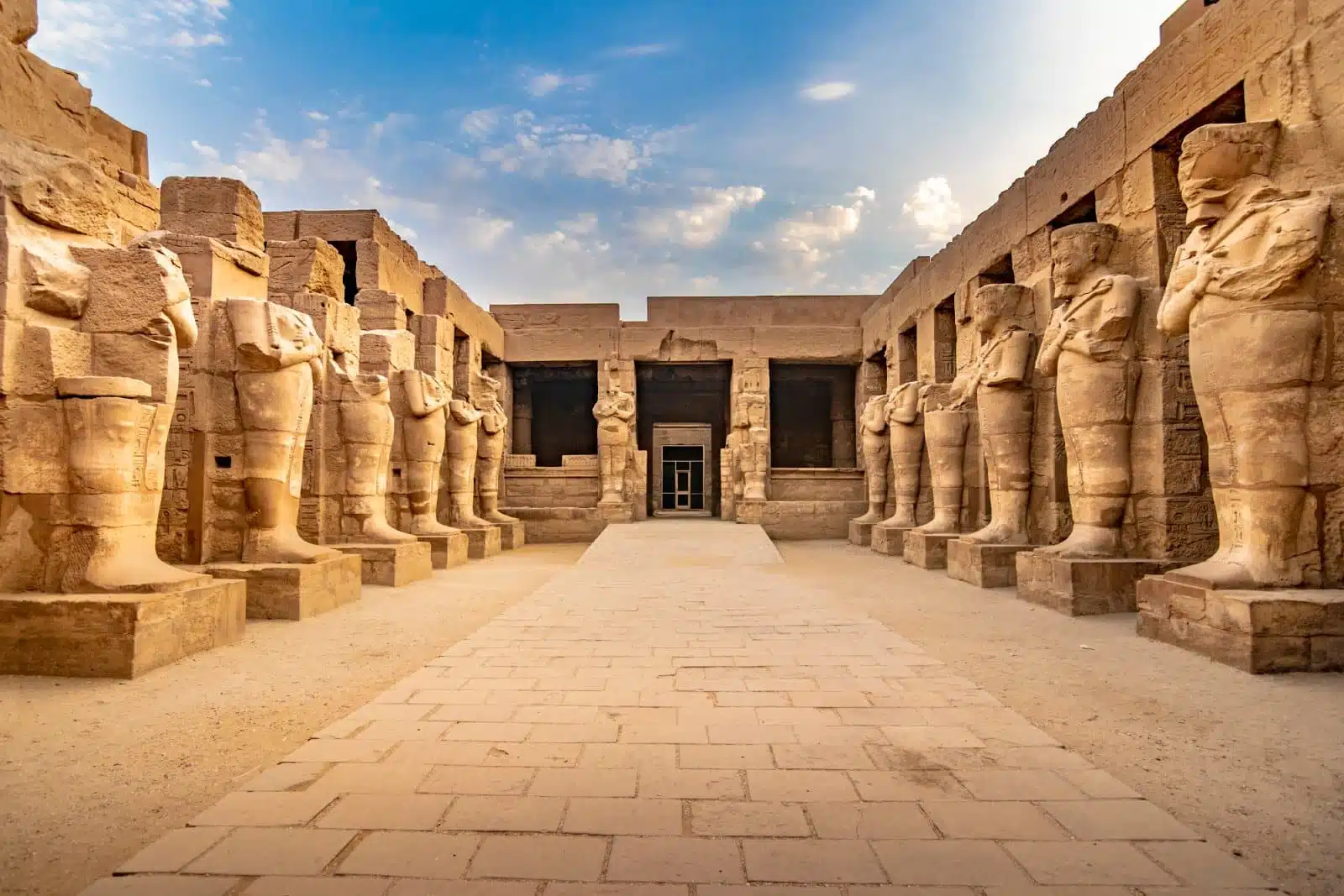
Image Credit: Shutterstock / Bist
Luxor, often called the world’s greatest open-air museum, holds treasures beyond time. At its heart, the Karnak Temple complex, a vast open-air museum of decayed temples, chapels, pylons, and other buildings primarily dedicated to Amun, highlights the religious devotion spanning over two thousand years. Walking through the Great Hypostyle Hall, with its towering columns inscribed with hieroglyphs, one can’t help but feel dwarfed by the ancient architects’ ambition and skill. Across the Nile, the Valley of the Kings offers a stark contrast with its hidden underground tombs, where the pharaohs of the New Kingdom period were laid to rest amidst riches and elaborate decorations intended for their journey into the afterlife. The tombs, including that of the young pharaoh Tutankhamun, reveal exquisite artistry and deep religious beliefs, offering a poignant glimpse into the Egyptians’ views on mortality and immortality.
Insider’s Tip: Purchase a comprehensive ticket that includes entry to multiple tombs in the Valley of the Kings, but save your visit to Tutankhamun’s tomb for last to fully appreciate its significance.
When to Travel: The cooler months from October to April are ideal for exploring Luxor’s archaeological treasures.
How to Get There: Luxor is accessible by air, with its international airport welcoming flights from major cities. Alternatively, trains from Cairo to Luxor offer a scenic route along the Nile.
3. Islamic Cairo
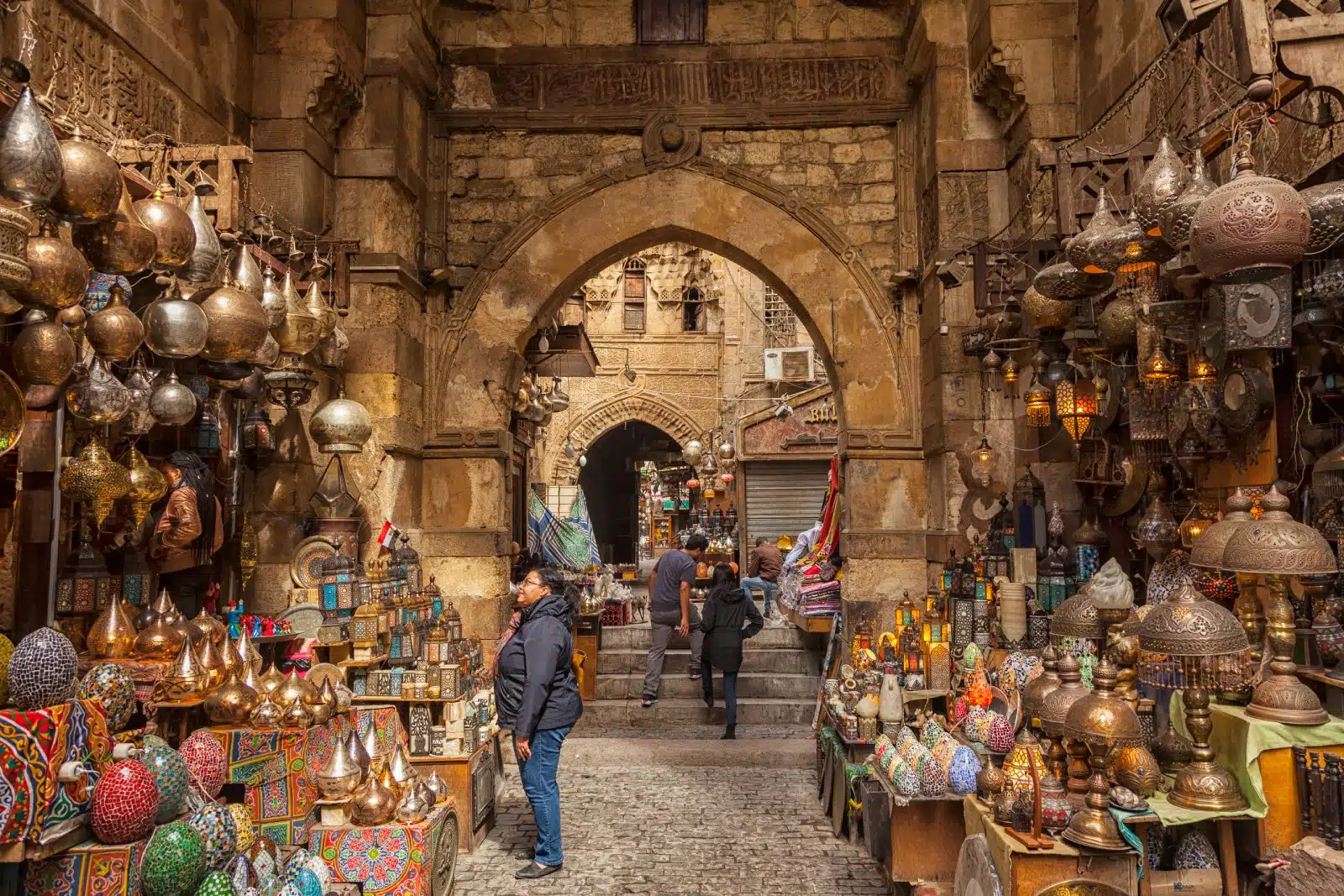
Image Credit: Shutterstock / Merydolla
Islamic Cairo, a historic area in the heart of Egypt’s bustling capital, is an Islamic architectural heritage treasure. With its narrow lanes and bustling markets, this district is home to one of the world’s oldest universities, Al-Azhar University, and numerous mosques, madrasas, and monuments dating from the Fatimid through to the Ottoman periods. The area’s rich tapestry of history is evident in the varied architectural styles and the stories behind landmarks like the Mosque of Ibn Tulun, one of Cairo’s oldest and largest mosques, and the Citadel, a medieval Islamic fortification offering panoramic views of the city. Exploring Islamic Cairo is as much about experiencing the vibrancy of contemporary life in the bazaars, such as Khan el-Khalili, as it is about discovering the past. The scent of spices, the sound of metalworkers, and the sight of intricately designed artifacts for sale in the souqs provide a sensory journey that complements the historical exploration.
Insider’s Tip: Engage a local guide to navigate the maze-like streets of Islamic Cairo and uncover hidden architectural gems and stories that bring the history of this area to life.
When to Travel: Autumn (September to November) and spring (February to April) offer pleasant weather for wandering through Islamic Cairo.
How to Get There: Islamic Cairo is centrally located and easily reached by taxi or public transport from any part of the city.
4. Aswan and the Temple of Philae
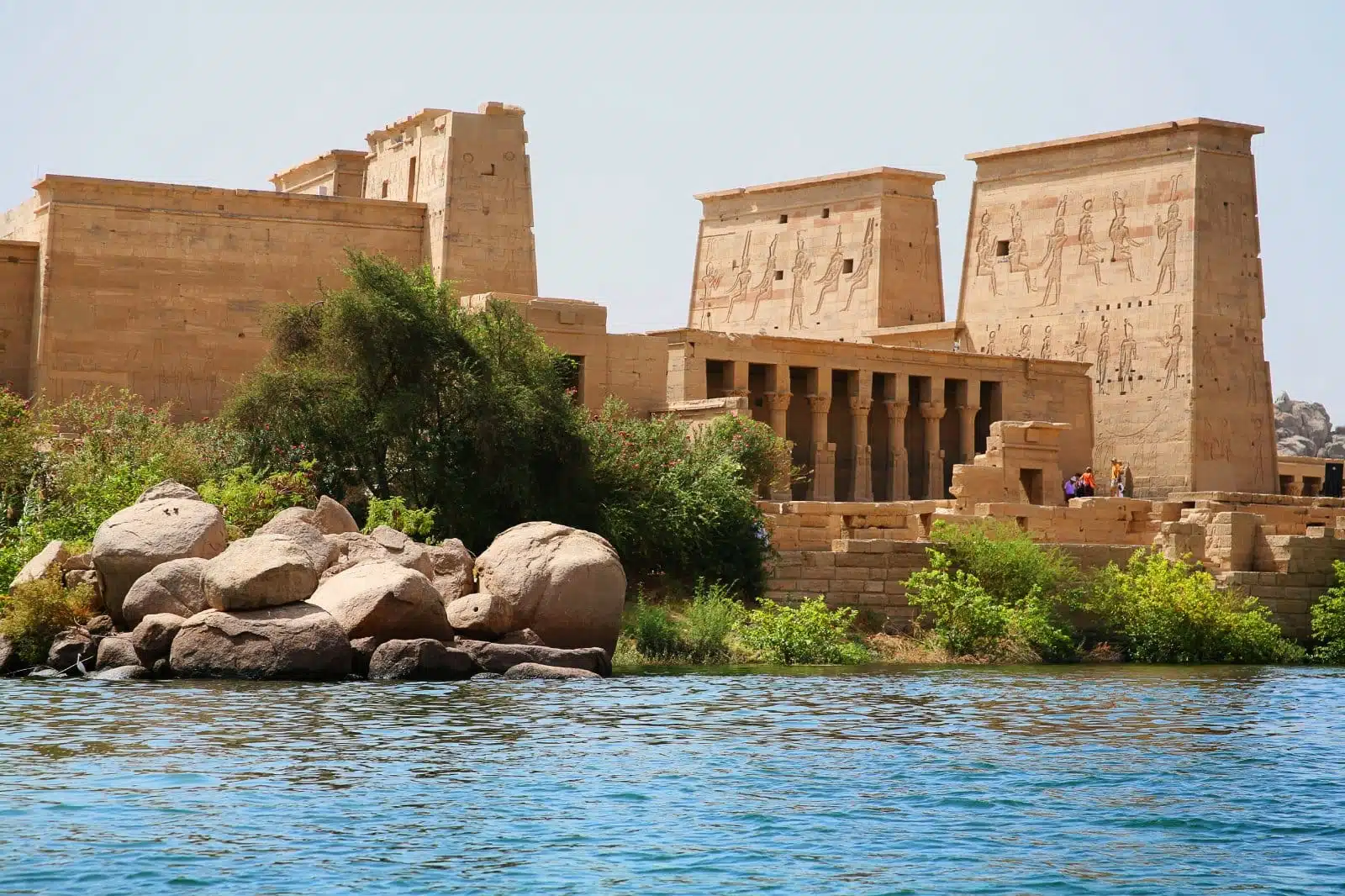
Image Credit: Shutterstock / Certe
Aswan, set upon the tranquil bends of the Nile far south of Cairo, offers a more serene and picturesque side of Egypt. This city, with its Nubian culture, colorful sails dotting the river, and islands lush with palm groves, stands in contrast to the ancient grandeur of much of the country. The Temple of Philae, dedicated to the goddess Isis, embodies Egyptian civilization’s resilience and enduring beauty. Relocated to Agilkia Island as part of a monumental UNESCO project to save it from the floods caused by the Aswan Dam, the temple complex is a historical and architectural feat. Visitors are often captivated by the temple’s intricate reliefs and the romantic setting on the island. With its slower pace of life, Aswan offers a chance to unwind and soak in the beauty of the Nile’s landscapes, making it a perfect blend of relaxation and exploration.
Insider’s Tip: Take a felucca ride at sunset for breathtaking views of the Nile against the backdrop of the Sahara Desert.
When to Travel: The mild winter months from October to February are the best time to visit Aswan, avoiding the extreme heat of summer.
How to Get There: Aswan has an international airport and is also reachable by train from Cairo or Luxor, offering a scenic journey along the Nile.
5. Alexandria’s Mediterranean Charm
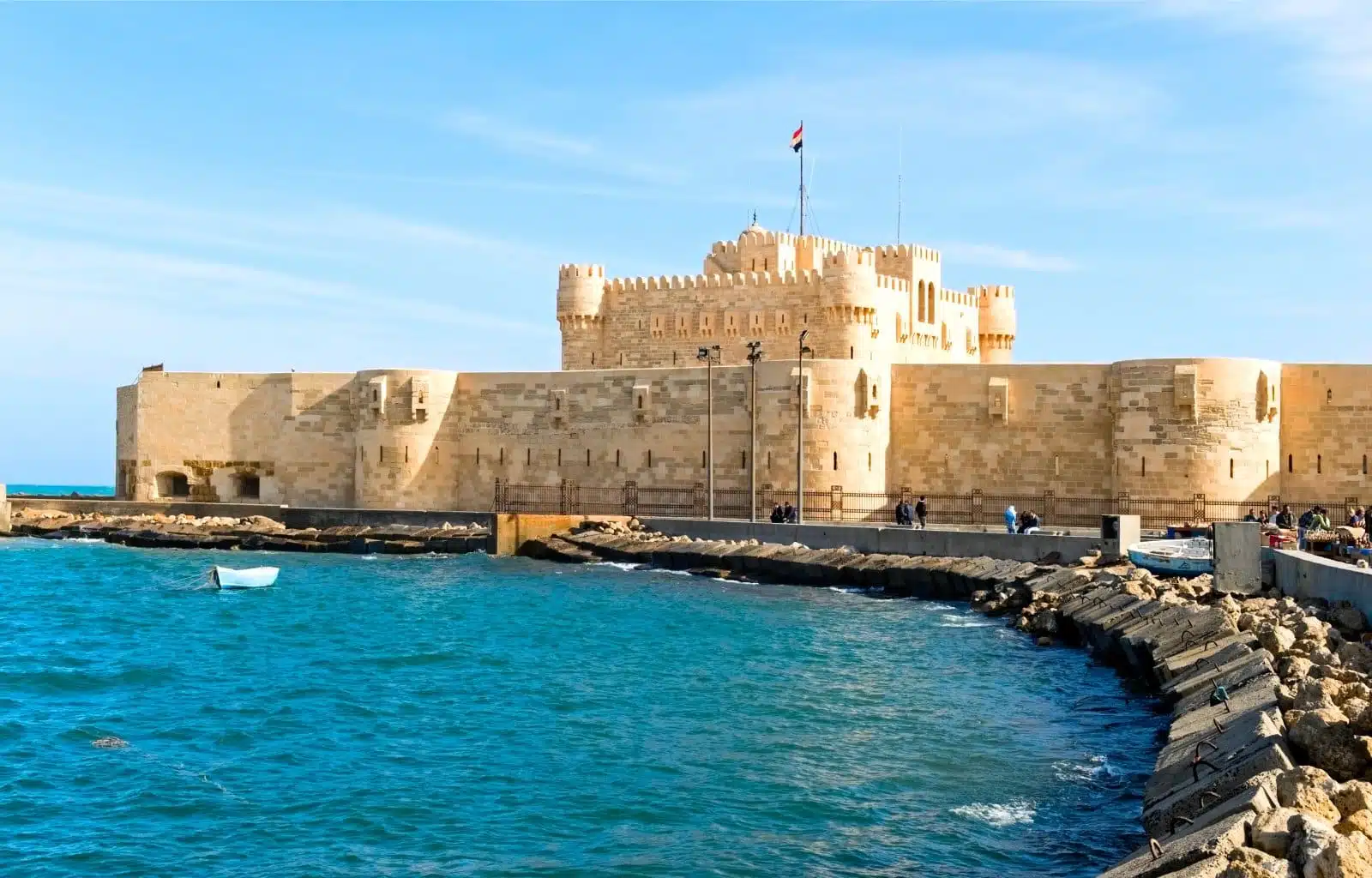
Image Credit: Shutterstock / krechet
Alexandria, the pearl of the Mediterranean, is steeped in history and culture, offering a refreshing contrast to Egypt’s inland wonders. Founded by Alexander the Great in 331 BC, this city was once the seat of learning and culture in the ancient world. Today, Alexandria invites visitors to explore its rich past through well-preserved Roman ruins, the modern Bibliotheca Alexandrina, and the serene Mediterranean Seafront. The city’s cosmopolitan atmosphere is palpable in its vibrant cafes, seafood restaurants, and bustling markets. Key historical sites include the Roman Amphitheatre, the catacombs of Kom el Shoqafa, and the Citadel of Qaitbay, which stands on the site of the ancient Lighthouse of Alexandria, one of the Seven Wonders of the Ancient World. Strolling along the Corniche, visitors can soak in the city’s bustling energy and Mediterranean breezes, offering a moment of reflection on the enduring legacy of this ancient metropolis.
Insider’s Tip: Enjoy a traditional seafood meal at one of the restaurants overlooking the Mediterranean for a taste of local cuisine.
When to Travel: Spring (March to May) and fall (September to November) offer mild weather, ideal for exploring the city.
How to Get There: Alexandria is easily accessible by train or bus from Cairo. The city also has two airports, though they primarily serve domestic and regional flights.
6. Siwa Oasis
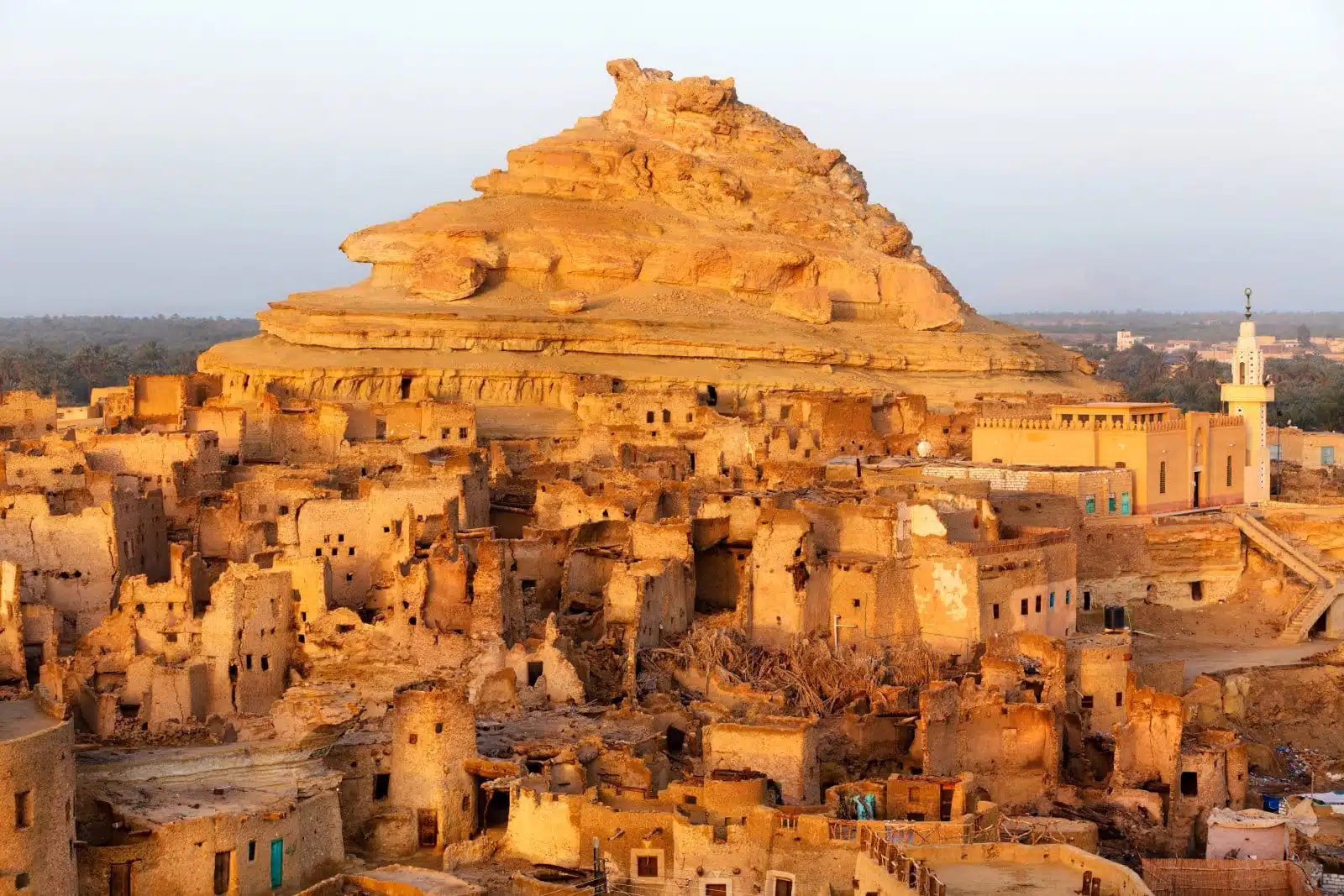
Image Credit: Shutterstock / NickolayV
Siwa Oasis, a secluded paradise in Egypt’s Western Desert, is an enchanting blend of natural beauty and rich cultural heritage. Known for its lush palm groves, olive orchards, and freshwater springs, Siwa is a world apart from the bustling cities and ancient ruins elsewhere in the country. With its distinct language and traditions, the local Berber community adds to the oasis’s allure. Siwa’s ancient Oracle Temple of Amun, where Alexander the Great was confirmed as a divine figure, and the ruins of the mud-brick Shali fortress, offer insights into the oasis’s long and varied history. The unique architecture of Siwan homes, constructed from kershef (salt and mud brick), and the serene beauty of the surrounding desert make Siwa a captivating destination for those seeking tranquility and a deeper connection with nature.
Insider’s Tip: Stay in a traditional Siwan mud-brick guesthouse for an authentic experience of local architecture and hospitality.
When to Travel: The cooler months from October to April are the best time to visit, avoiding the summer heat.
How to Get There: Siwa is most accessible by road, with bus services from Cairo or Marsa Matrouh. The journey offers stunning desert landscapes.
7. The Red Sea Riviera
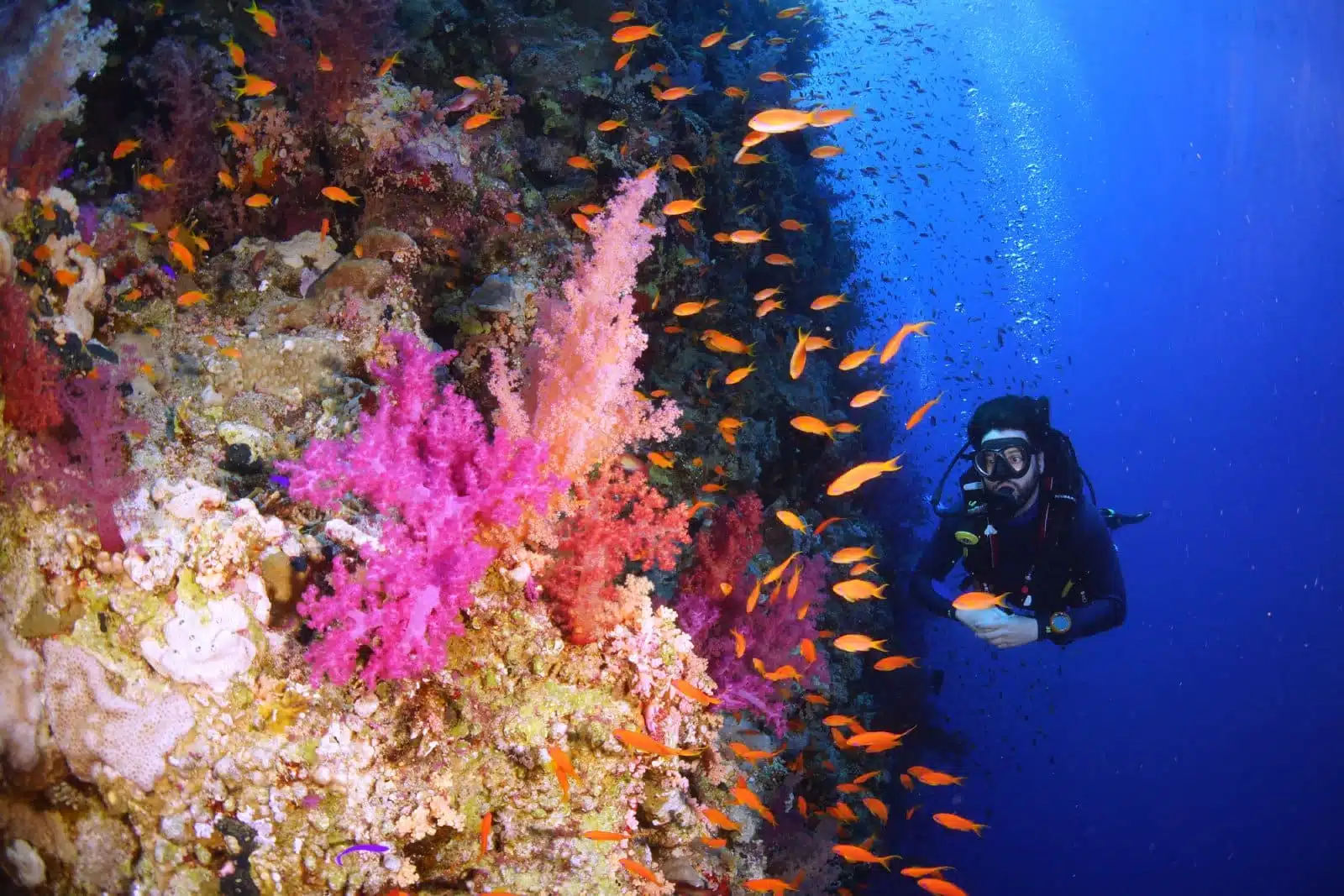
Image Credit: Shutterstock / Cinzia Osele
Egypt’s Red Sea Riviera is a haven for divers, snorkelers, and sun-seekers, known for its crystal-clear waters, vibrant coral reefs, and year-round sunshine. Resorts like Sharm El Sheikh, Hurghada, and Marsa Alam are gateways to underwater wonders, including the famous Thistlegorm wreck and the Ras Mohammed National Park. The Red Sea’s marine biodiversity is unparalleled, with opportunities to spot dolphins, turtles, and hundreds of fish species. Beyond the beach, the Red Sea Riviera offers adventures in the desert, including safaris and Bedouin dinners under the stars. The region’s commitment to conservation ensures that its natural beauty is preserved for future generations, making it a sustainable choice for eco-conscious travelers.
Insider’s Tip: For a quieter experience, consider staying in Marsa Alam or Dahab, which offer beautiful reefs and a more laid-back atmosphere.
When to Travel: It is a year-round destination, but March to May and September to November offer the best conditions for diving and snorkeling.
How to Get There: Hurghada and Sharm El Sheikh have international airports with flights from major cities. Marsa Alam also has an airport that serves mostly charter flights.
8. The White Desert National Park
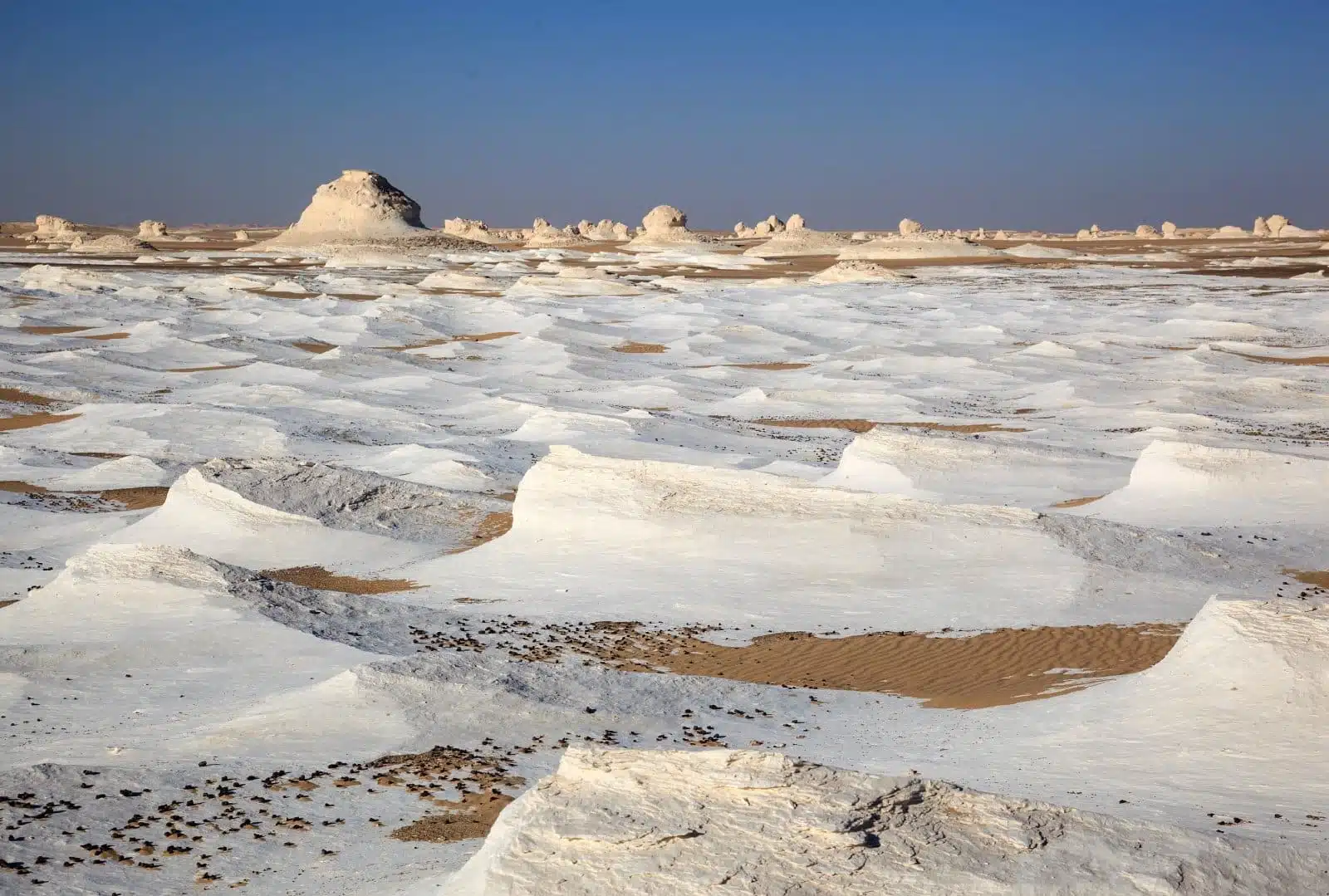
Image Credit: Shutterstock / kataleewan intarachote
The White Desert National Park, located roughly midway between Farafra and Bahariya Oasis, is an otherworldly landscape that captivates the imagination. Known for its surreal chalk rock formations sculpted by centuries of sandstorms, the park resembles a snow-covered landscape under the bright desert sun. These natural sculptures come in various shapes, some resembling giant mushrooms or pebbles, creating a dreamlike atmosphere that feels more akin to a science fiction scene than a desert on Earth. The White Desert is part of Egypt’s larger Western Desert, starkly contrasting the fertile Nile Valley and the bustling cities. A visit here, especially during sunrise or sunset when the rocks glow with orange and pink hues, provides a profound sense of solitude and wonder. For those adventurous enough to stay overnight, camping under the stars reveals a sky of unparalleled clarity, untouched by light pollution, showcasing the Milky Way in all its glory.
Insider’s Tip: Overnight camping trips, led by local Bedouin guides, provide the full experience of the desert’s beauty and tranquility.
When to Travel: The cooler months from October to April are ideal for visiting the desert.
How to Get There: The White Desert is best accessed from Bahariya Oasis, which is about a 4-hour drive from Cairo. Guided tours usually arrange transportation.
9. Dahab and the Sinai Peninsula
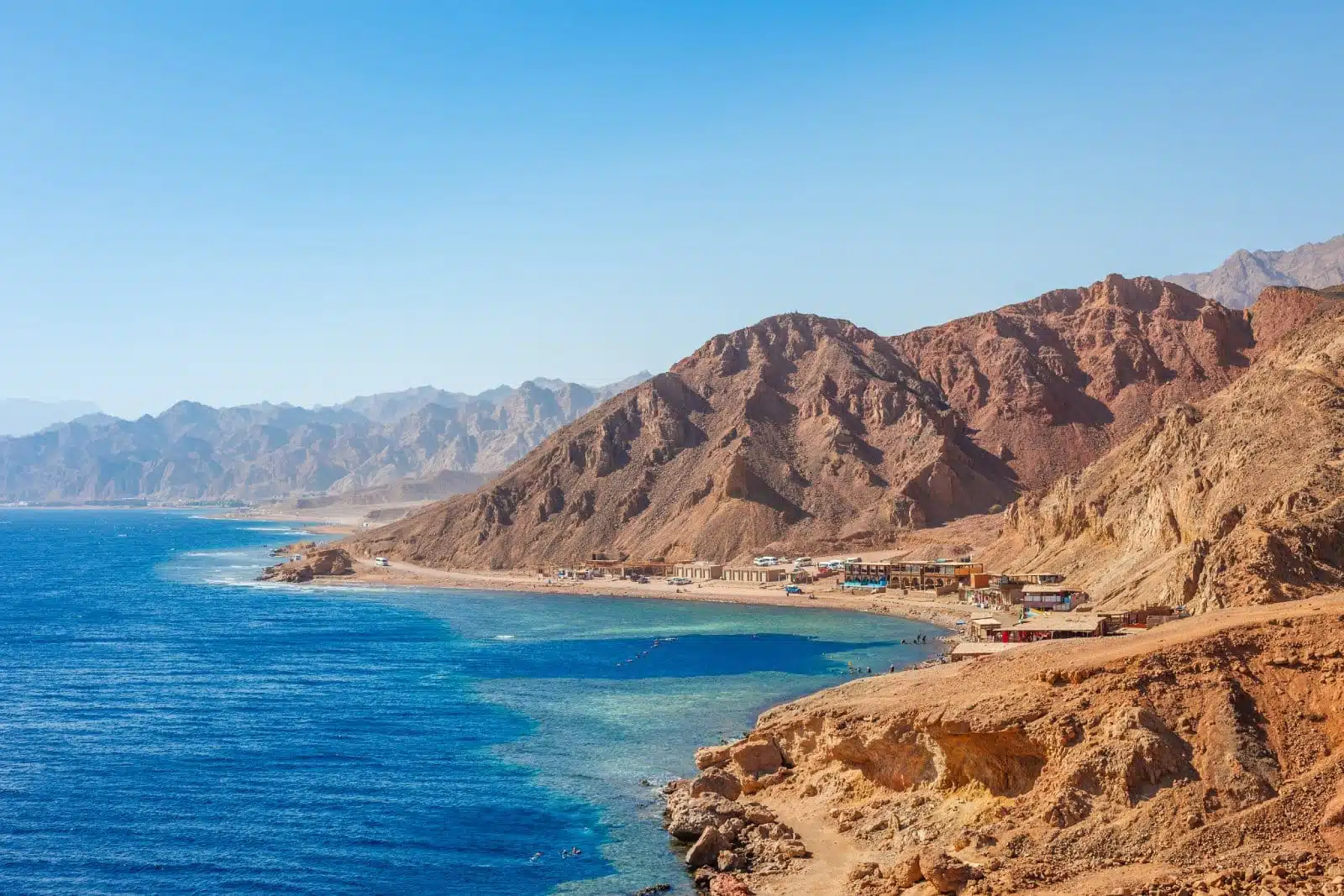
Image Credit: Shutterstock / Oleg_P
Dahab, on the southeast coast of the Sinai Peninsula, is a laid-back town that has long been a favorite among backpackers, divers, and those searching for a peaceful retreat. Known for its golden beaches, the Blue Hole, and the vibrant coral reefs just offshore, Dahab offers some of the best diving and snorkeling in the world. The town’s relaxed atmosphere is complemented by a range of activities, from yoga and windsurfing to desert safaris and mountain climbing in the nearby Sinai mountains. Dahab’s blend of natural beauty, adventure opportunities, and Bedouin culture makes it a unique destination within Egypt, offering a different pace of life and a chance to connect with the natural environment.
Insider’s Tip: Explore the desert on a camel safari or by quad bike for an adventurous experience beyond the beach or head to Castle Zaman for a dinner of a lifetime!
When to Travel: Spring (March to May) and fall (September to November) offer the best weather for both diving and desert excursions.
How to Get There: Dahab is about an hour’s drive from Sharm El Sheikh International Airport. Buses also run between the two towns.
10. The Nile River Cruise
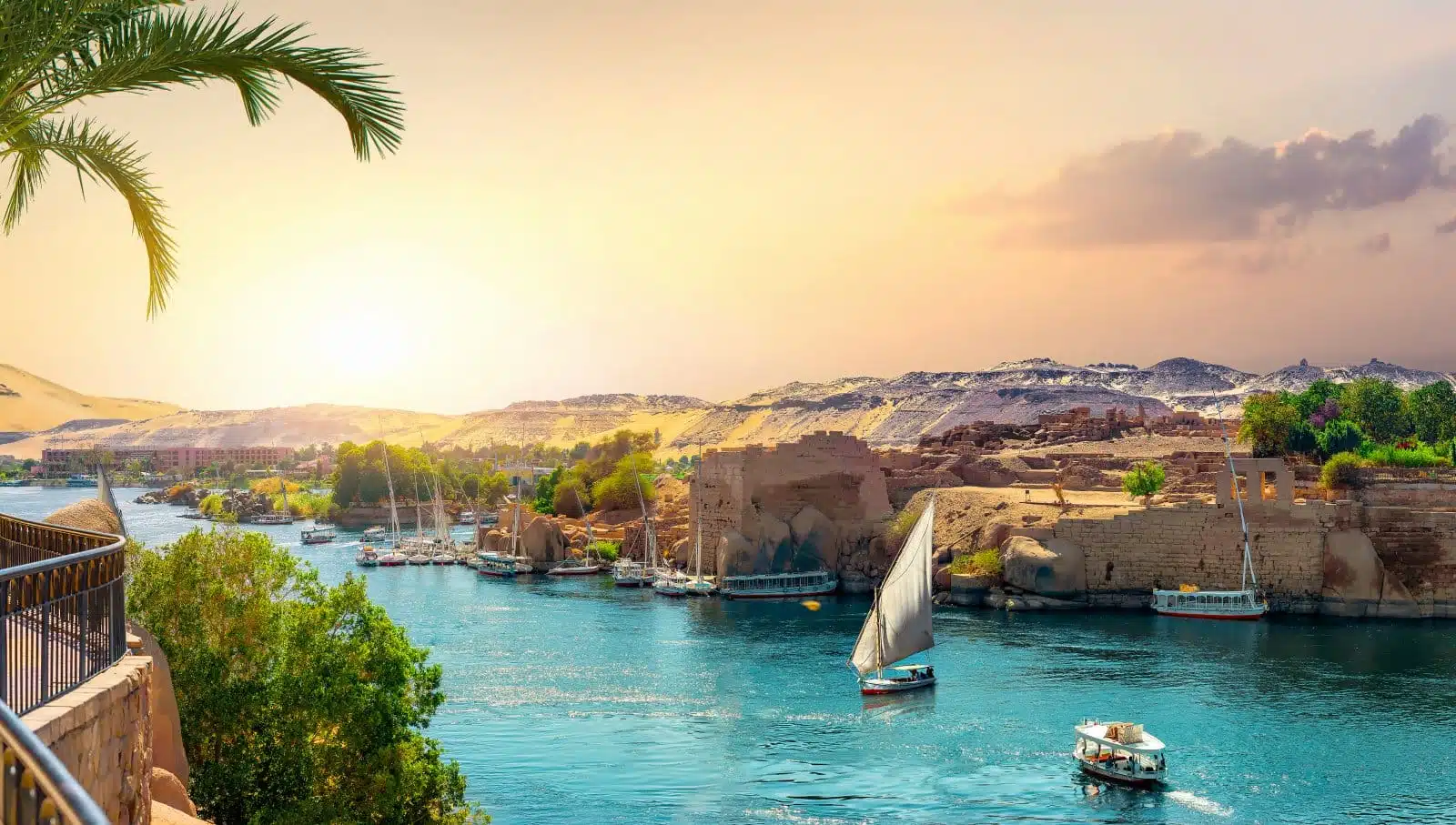
Image Credit: Shutterstock / givaga
A Nile River cruise is a quintessential Egyptian experience, offering a leisurely way to explore the country’s ancient heartland. Gliding between Luxor and Aswan, passengers witness life along the Nile’s banks, unchanged in many ways since the time of the pharaohs. Stops at iconic sites such as the temples of Karnak and Luxor, the Valley of the Kings, Edfu, and Kom Ombo allow for in-depth exploration of Egypt’s monumental history. Modern cruise boats provide comfortable accommodations and amenities, ensuring a relaxing journey through Egypt’s landscapes and millennia of history. A Nile cruise connects the major archaeological sites in a meaningful sequence and offers a glimpse into the enduring importance of the Nile to Egyptian civilization.
Insider’s Tip: Choose a cruise that includes visits to lesser-known sites along the Nile for a more comprehensive understanding of ancient Egyptian civilization.
When to Travel: The best time for a Nile cruise is from October to April, when the weather is cooler.
How to Get There: Most Nile cruises start in Luxor or Aswan. Both cities have airports with domestic flights from Cairo and, in some cases, international connections.
11. Abu Simbel
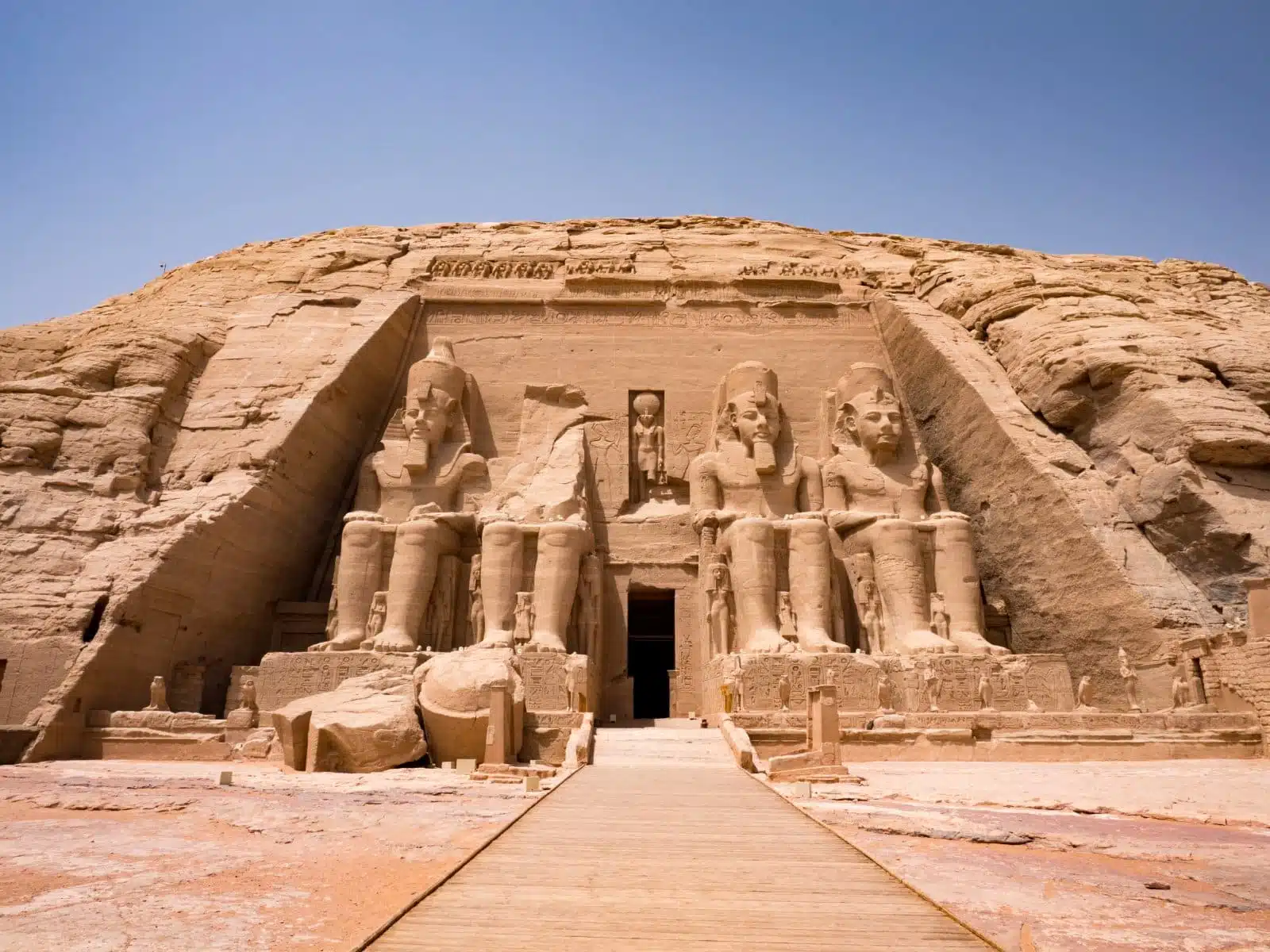
Image Credit: Shutterstock / doleesi
Abu Simbel remains one of Egypt’s most awe-inspiring sites, where Ramses II and his queen, Nefertari’s colossal temples overlook Lake Nasser. Constructed in the 13th century BC, these temples were an assertion of Ramses II’s divine might and his love for Nefertari. The relocation of these temples in the 1960s, a monumental effort to save them from the rising waters of Lake Nasser due to the Aswan High Dam, stands as a testament to global cooperation for preserving cultural heritage. The grandeur of the statues, the intricate wall carvings depicting victorious battles, and the alignment of the sun during the Sun Festival, illuminating the inner sanctum, all contribute to the site’s mystique and grandiosity.
Insider’s Tip: Time your visit to coincide with the biannual Sun Festival (October 22 and February 22), when the sun illuminates the inner sanctum’s statues, except for Ptah, the god of darkness.
When to Travel: The cooler months from October to April are ideal, offering a more comfortable exploration of the temples.
How to Get There: Abu Simbel is accessible by air from Cairo or Aswan, with EgyptAir offering daily flights. Alternatively, road convoys or organized tours depart from Aswan, providing a scenic route through the desert.
12. Suez Canal
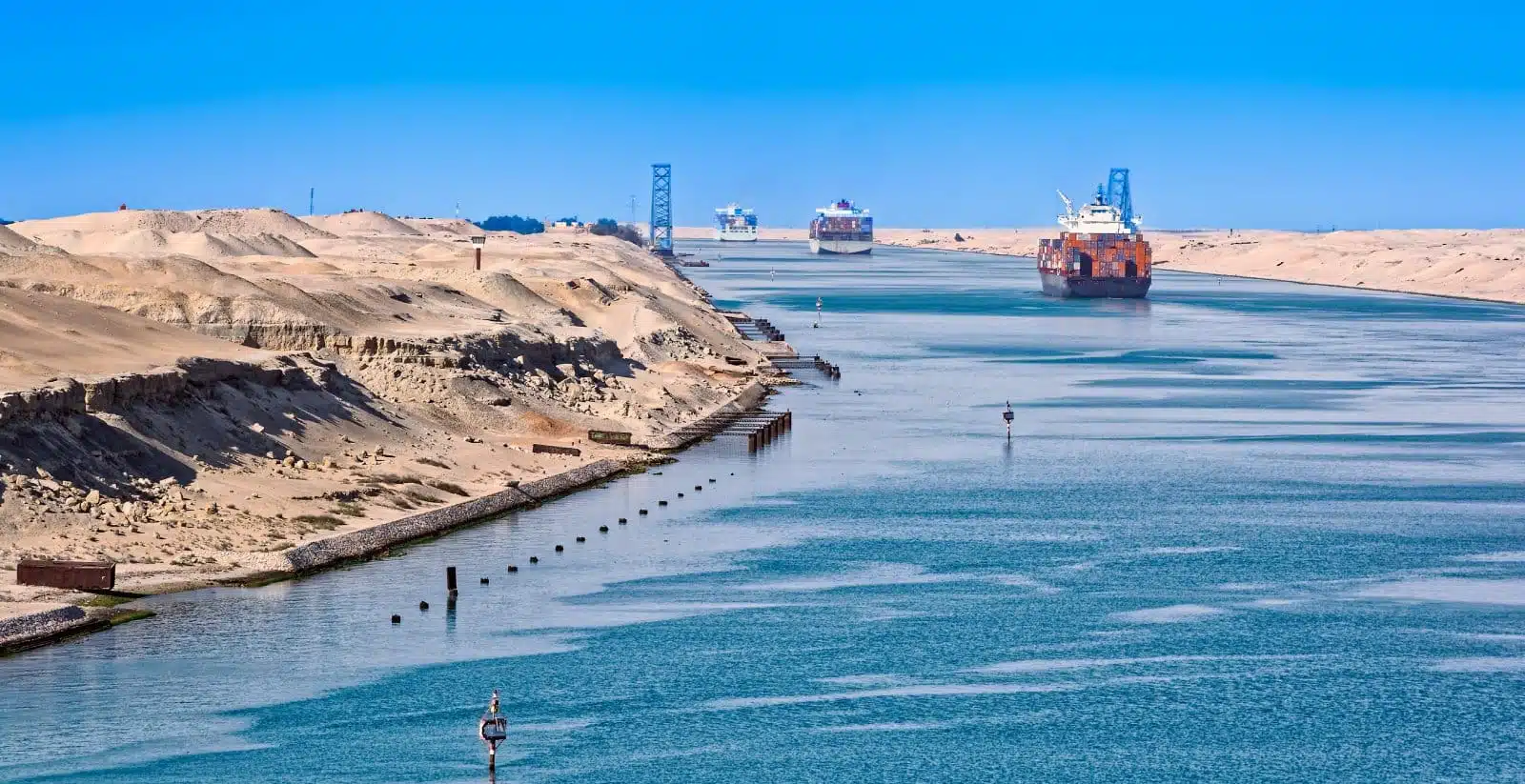
Image Credit: Shutterstock / Igor Grochev
The Suez Canal, an engineering marvel that connects the Mediterranean Sea to the Red Sea, has played a pivotal role in international trade routes since its completion in 1869. Observing the passage of ships through this man-made waterway offers a unique perspective on the complexities of global commerce and engineering. The canal’s strategic importance is matched by its historical significance, having been a focal point in international relations and conflicts. Visitors can explore the canal’s history further at the Suez Canal Authority’s museum in Ismailia, which provides comprehensive insights into its construction, operation, and impact on global navigation.
Insider’s Tip: Visit the Suez Canal Authority’s museum in Ismailia to gain deeper insights into the canal’s construction and its impact on global trade.
When to Travel: Spring (March to May) and fall (September to November) offer pleasant weather for visiting the canal and surrounding areas.
How to Get There: The Suez Canal is easily reached by bus or car from Cairo. Each of the canal cities (Ismailia, Port Said, Suez) is accessible via major highways.
13. Alexandria’s Bibliotheca Alexandrina
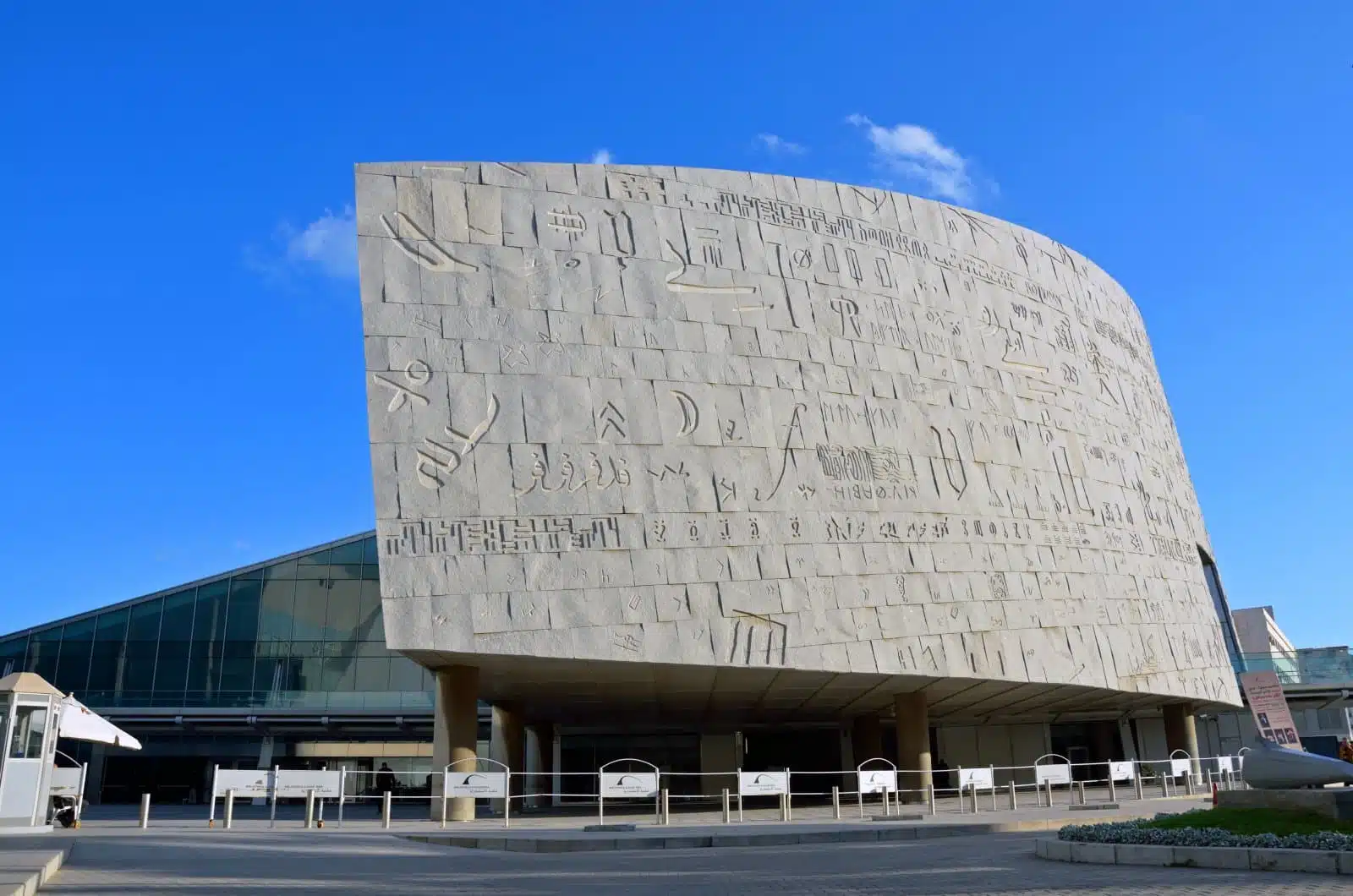
Image Credit: Shutterstock / suronin
The Bibliotheca Alexandrina, a striking piece of contemporary architecture and intellectual beacon, is a tribute to the ancient Library of Alexandria, one of the ancient world’s largest and most significant libraries. This modern library is not only a center for learning and culture, with millions of books, manuscripts, and a host of museums and art galleries, but also a symbol of Egypt’s dedication to cultural exchange and preservation. Its design, featuring a vast sun disk, mirrors the city’s connection to the Mediterranean and its historical significance as a center of knowledge and scholarship.
Insider’s Tip: Check the library’s schedule for cultural events, workshops, and exhibitions, often featuring international artists and speakers.
When to Travel: Alexandria is beautiful year-round, but spring (March to May) and fall (September to November) offer the most comfortable climate for exploring the city.
How to Get There: Alexandria is well-connected by train and bus services from Cairo. The Bibliotheca Alexandrina is located in the city’s eastern harbor and is easily accessible by public transport or taxi within Alexandria.
14. Mount Sinai and St. Catherine’s Monastery
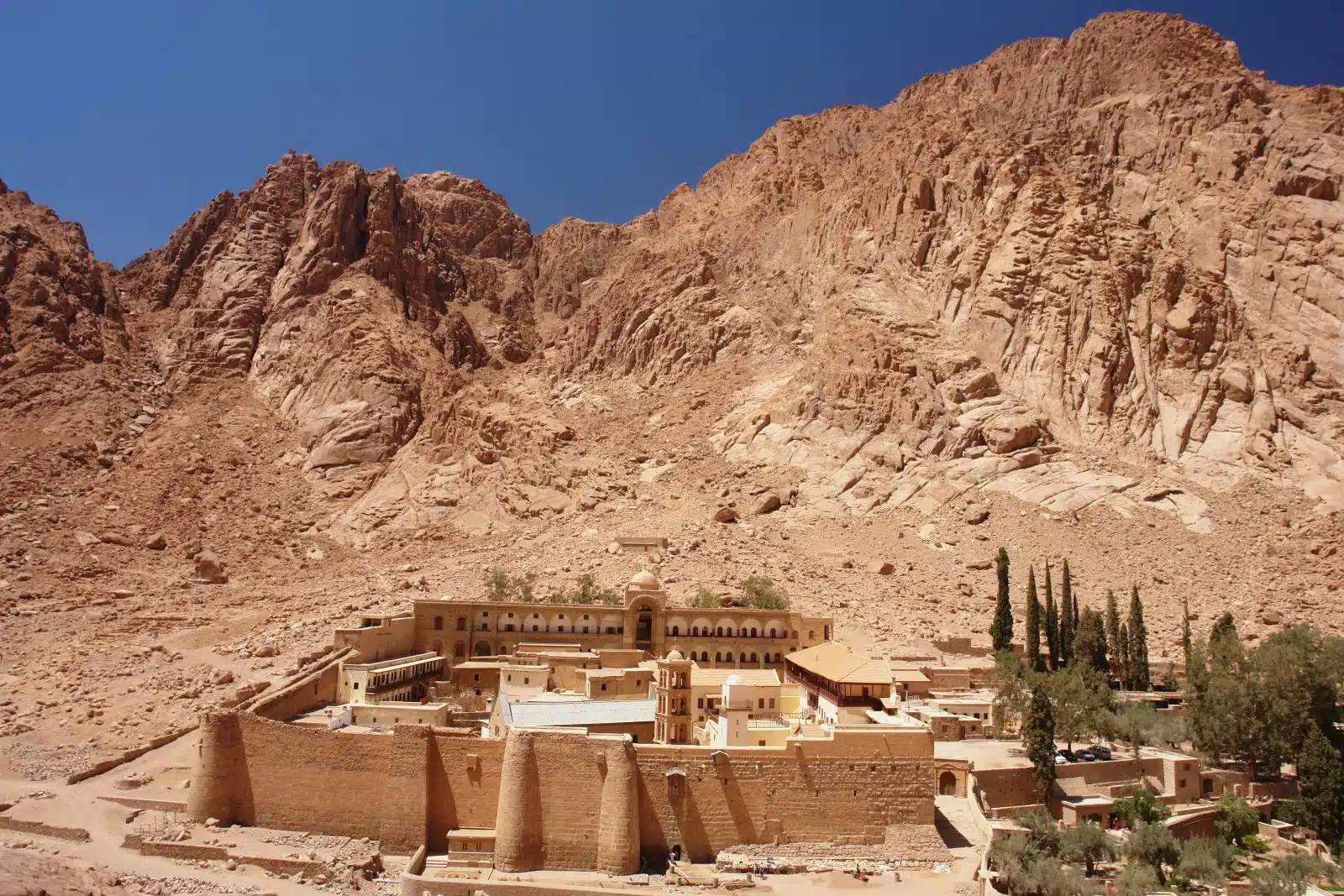
Image Credit: Shutterstock / Mildax
Mount Sinai, a mountain of profound religious and historical significance, is believed to be where Moses received the Ten Commandments. The rugged climb to its summit is rewarded with breathtaking sunrise views, a spiritual experience for many. St. Catherine’s Monastery is located at its base, an ancient Christian site home to a rich collection of religious manuscripts, icons, and art. This area’s blend of natural beauty and spiritual depth offers a reflective journey back in time, providing insights into the monotheistic religions that hold this mountain sacred.
Insider’s Tip: Opt for the camel path for a less strenuous ascent to Mount Sinai’s summit, saving your energy for the descent via the Steps of Repentance.
When to Travel: Spring (March to May) and fall (September to November) provide the best weather conditions for the hike and exploration of the monastery.
How to Get There: Mount Sinai and St. Catherine’s Monastery are most commonly accessed from Sharm El Sheikh or Dahab, with organized tours or private taxis available for the journey.
15. The Fayoum Oasis
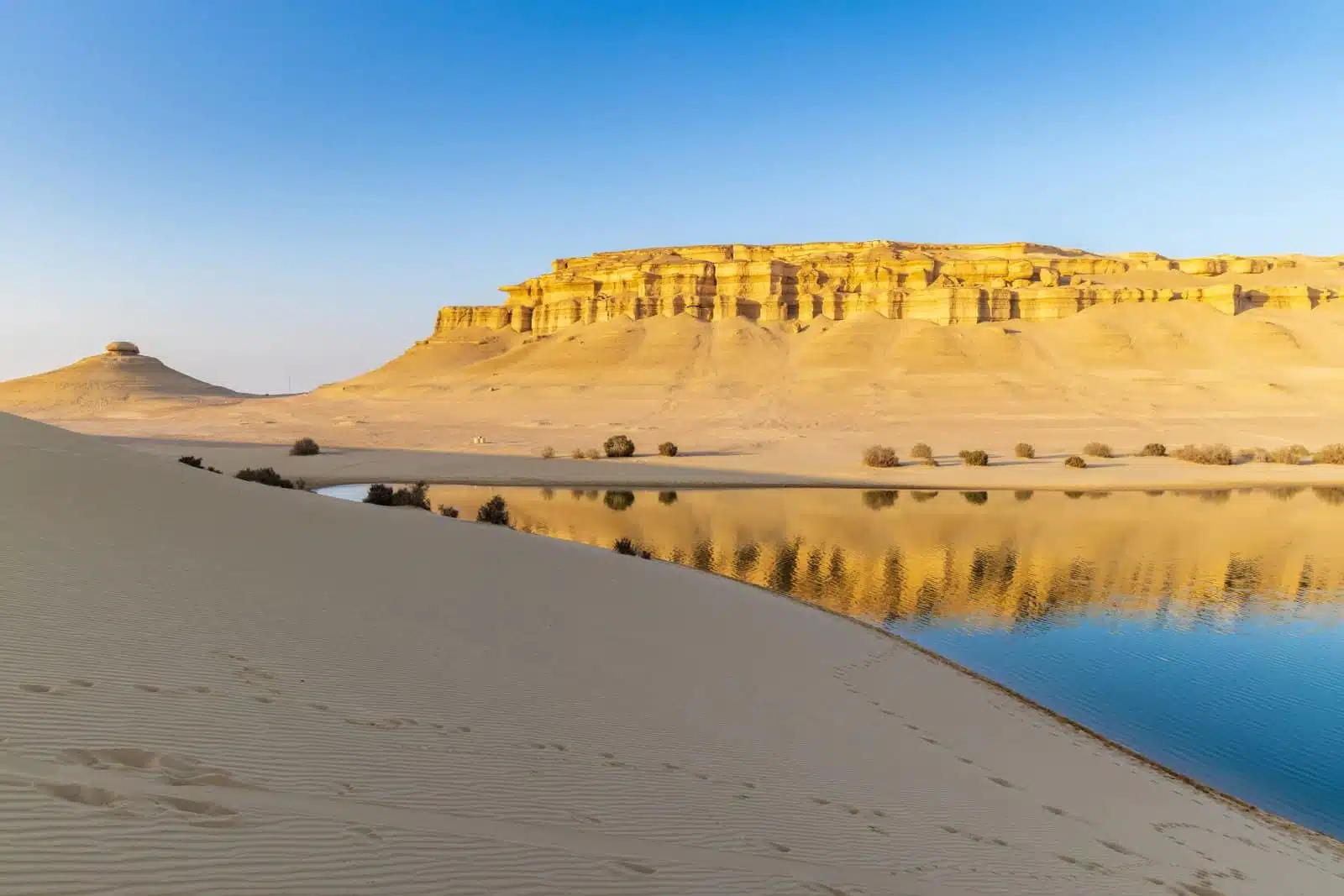
Image Credit: Shutterstock / Emily Marie Wilson
The Fayoum Oasis, a verdant haven amidst the desert, offers a glimpse into Egypt’s diverse landscapes and history. Known for its water wheels introduced by the Ptolemies, the oasis is a rich agricultural area with a history stretching back millennia. Attractions like the Wadi El Rayan waterfalls, the Whale Valley where fossils of prehistoric whales have been uncovered, and the ancient city of Karanis, reveal the oasis’s natural, historical, and cultural layers. The blend of lush landscapes, ancient ruins, and unique geological sites makes the Fayoum Oasis a captivating destination for those exploring beyond Egypt’s traditional tourist paths.
Insider’s Tip: Don’t miss a visit to Wadi Al-Hitan to see the fossilized remains of prehistoric whales, offering a fascinating glimpse into the area’s geological past.
When to Travel: The cooler months from October to April are the most comfortable for exploring the oasis and its surroundings.
How to Get There: The Fayoum Oasis is about a 90-minute drive from Cairo. It’s best accessed by car, allowing for flexibility in exploring the oasis and nearby attractions.
The Bottom Line

Image Credit: Shutterstock / Skreidzeleu
Egypt’s vast landscapes, from the timeless Nile River and majestic pyramids to the tranquil oases and the bustling streets of Cairo, offer a journey through history, culture, and natural beauty. Each destination presents an opportunity to connect with the past, immerse in the present, and ponder the future. As you plan your Egyptian adventure, embrace the diversity of experiences available, from the awe-inspiring to the serene. Remember, Egypt is a land of discovery, waiting to reveal its secrets to those who seek them.
More From The Green Voyage
Top 10 Trending Travel Destinations 2024
6 Essential Banking Apps for International Travel – Managing Your Finances on the Go
Traveling With Kids – 10 Tips to Create Memorable Family Holidays
The post A Country Guide to Egypt first appeared on The Green Voyage.
Featured Image Credit: Shutterstock / AlexAnton.
For transparency, this content was partly developed with AI assistance and carefully curated by an experienced editor to be informative and ensure accuracy.
Tips for Trip Success
Book Your Flight
Find an inexpensive flight by using Kayak, a favorite of ours because it regularly returns less expensive flight options from a variety of airlines.
Book Your Hotel or Special Accommodation
We are big fans of Booking.com. We like their review system and photos. If we want to see more reviews and additional booking options, we go to Expedia.
You Need Travel Insurance!
Good travel insurance means having total peace of mind. Travel insurance protects you when your medical insurance often will not and better than what you get from your credit card. It will provide comprehensive coverage should you need medical treatment or return to the United States, compensation for trip interruption, baggage loss, and other situations.Find the Perfect Insurance Plan for Your Trip
